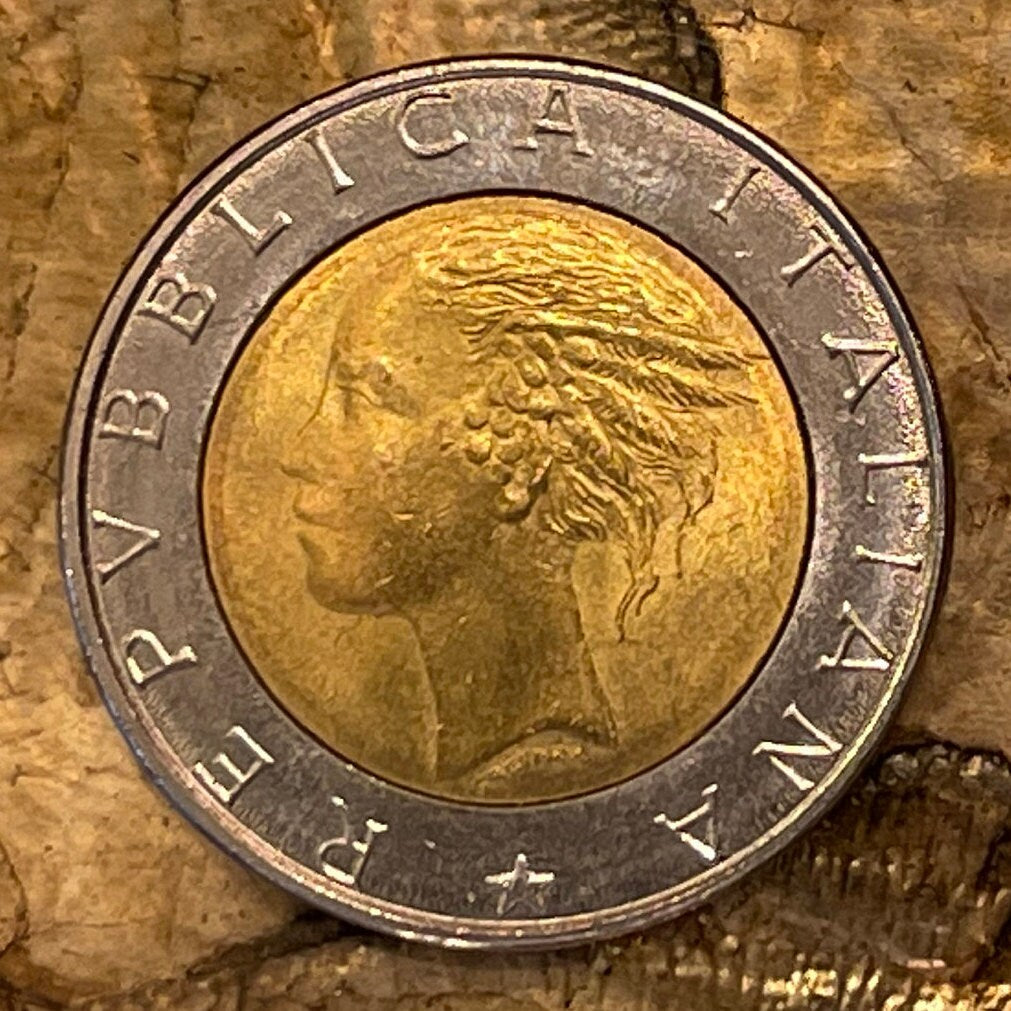elemintalshop
Horse-Tamers Statue at Quirinal Palace 500 Lire Italy Authentic Coin Money for Jewelry (Obelisk) (Gemini) (Bimetallic) (Castor and Pollux)
Horse-Tamers Statue at Quirinal Palace 500 Lire Italy Authentic Coin Money for Jewelry (Obelisk) (Gemini) (Bimetallic) (Castor and Pollux)
Couldn't load pickup availability
Horse Tamers Statue of Castor and Pollux at Quirinal Palace in Piazza del Quirinale 500 Lire Italy Authentic Coin Money for Jewelry and Craft Making (Palazzo del Quirinale) (Monte Cavallo) (Obelisk) (Dioscuri) (Gemini Twins)
Reverse: In the center a view of the Piazza del Quirinale, Rome, featuring the Obelisk (at left), one of the huge Castor and Pollux "Horse Tamers" statues (center), and the president's residence, the Palazzo del Quirinale (in the background). Small date in lower position. Value ("L.500") in Braille at top of the outer ring, as text at the bottom; plants on either sides.
Lettering:⠨⠇⠄⠼⠑⠚⠚⠄
L.500
Obverse: Female head facing left. The woman symbolizes the Italian Republic with feathered wings coming from temples (symbols of intelligence and freedom).
Lettering: REPVBBLICA ITALIANA
Translation:
Italian Republic
Features
Issuer Italy
Period Republic (1946-date)
Type Standard circulation coin
Years 1982-2001
Value 500 Lire (500 ITL)
Currency Lira (1861-2001)
Composition Bimetallic: bronzital centre in acmonital ring
Weight 6.8 g
Diameter 25.8 mm
Thickness 1.8 mm
Shape Round
Technique Milled
Orientation Coin alignment ↑↓
Demonetized 28 February 2002
Number N# 302
References KM# 111, Schön# 110
Wikipedia:
The colossal pair of marble "Horse Tamers"—often identified as Castor and Pollux—have stood since antiquity near the site of the Baths of Constantine on the Quirinal Hill, Rome. Napoleon's agents wanted to include them among the classical booty removed from Rome after the 1797 Treaty of Tolentino, but they were too large to be buried or to be moved very far. They are fourth-century Roman copies of Greek originals. They gave to the Quirinal its medieval name Monte Cavallo (Italian for 'Horse Mountain'), which lingered into the nineteenth century. Their coarseness has been noted, while the vigor—notably that of the horses—has been admired. The Colossi of the Quirinal are the original exponents of this theme of dominating power, which has appealed to powerful patrons since the seventeenth century, from Marly-le-Roi to Saint Petersburg.
The huge sculptures were noted in the medieval guidebook for pilgrims, Mirabilia Urbis Romae. Their ruinous bases still bore inscriptions OPUS FIDIÆ and OPUS PRAXITELIS, hopeful attributions that must have dated from Late Antiquity (Haskell and Penny 1981, p 136). The Mirabilia confidently reported that these were "the names of two seers who had arrived in Rome under Tiberius, naked, to tell the 'bare truth' that the princes of the world were like horses which had not yet been mounted by a true king."
Between 1589 and 1591, Sixtus V had them restored and set on new pedestals flanking a fountain, another engineering triumph for Domenico Fontana, who had moved and re-erected the obelisk in Piazza San Pietro. In 1783-86 they were re-set at an angle, and an obelisk, which had recently been found at the Mausoleum of Augustus, was re-erected between them. (The present granite basin, which had served for watering cattle in the Roman Forum was set between them instead in 1818.)
An interpretation of their subject as Alexander and Bucephalus was proposed in 1558 by Onofrio Panvinio, who suggested that Constantine had removed them from Alexandria, where they would have referred to the familiar legend of the city's founder. This became a popular alternative to their identification as the Dioscuri. The popular guides still referred to their creation by Phidias and Praxiteles competing for fame, long after even the modestly learned realized that the two sculptors preceded Alexander by a century.
*******
The Quirinal Palace (Italian: Palazzo del Quirinale [paˈlattso del kwiriˈnaːle]) is a historic building in Rome, Italy, one of the three current official residences of the President of the Italian Republic, together with Villa Rosebery in Naples and the Tenuta di Castelporziano, an estate on the outskirts of Rome, some 25 km from the centre of the city. It is located on the Quirinal Hill, the highest of the seven hills of Rome in an area colloquially called Monte Cavallo. It has served as the residence for thirty Popes, four Kings of Italy and twelve Presidents of the Italian Republic.
The Quirinal Palace was selected by Napoleon to be his residence par excellence as Emperor. However, he never stayed there because of the French defeat in 1814 and the subsequent European Restoration.
The palace extends for an area of 110,500 square metres and is the eleventh-largest palace in the world in terms of area, some twenty times the area of the White House.
******
The Quirinal Hill (/ˈkwɪrɪnəl/; Latin: Collis Quirinalis; Italian: Quirinale [kwiriˈnaːle]) is one of the Seven Hills of Rome, at the north-east of the city center. It is the location of the official residence of the Italian head of state, who resides in the Quirinal Palace; by metonymy "the Quirinal" has come to stand for the Italian president.
Share










5 stars review from Nicole









